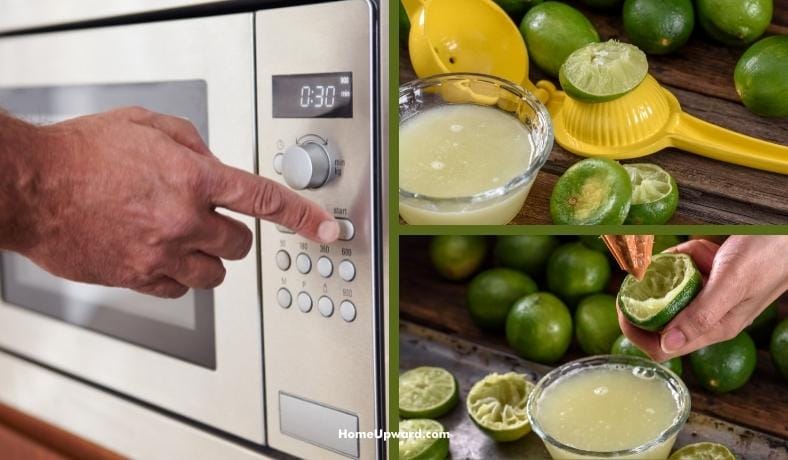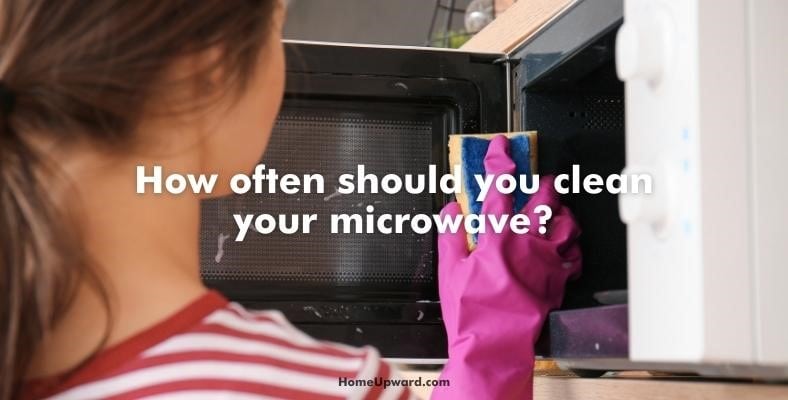Contents
How To Clean a Microwave With Lime Juice
Why Are Lemons and Limes Good for Cleaning?
Lemons and limes are great natural cleaning agents because the slight acidity of the citrus fruits efficiently eats through grease and other food residues in your microwave without causing any damage to the appliance.
Most citrus fruits are great for cleaning because of their acidity and the fresh scent they leave behind. It’s especially effective when mixed with another product like baking soda or water.
While lemons will help you achieve a clean microwave, limes work just as well! Here are a few steps to clean your microwave with lime juice.
Steps for Cleaning a Microwave With Lime Juice
1. Mixing the Lime and Water
Combine one cup of water with the juice from one lime. You can place the lime peels right in with the lime juice and water mixture.
Mix thoroughly with a spoon or whisk.
2. Place the Bowl & Heat
Next, place the bowl in the microwave and heat it. Be sure to use a microwave-safe bowl. The best option is a glass container.
Heat the mixture for several minutes on high power until it is boiling and steaming inside the microwave. (You may need 4-6 minutes or so depending on the power rating of your microwave oven.)
3. Let It Cool Then Clean
Let the liquid cool for about 5 minutes after the microwave cycle. Next, remove the bowl and wipe the microwave clean with a damp washcloth.
The food residue might still be stuck on the microwave door and inside but it should come off with a damp cloth or paper towel. Mop up the excess debris without smearing it around the inside of the microwave.
Is It Better To Clean a Microwave With Lemon or Vinegar?
Cleaning a microwave with lemon or vinegar is a good idea and in fact better to use than a harsh chemical cleaner like bleach That’s because bleach and others aren’t food-safe and it can even damage the interior of your microwave.
Generally speaking, when it comes to lemon/lime vs vinegar for cleaning:
- Lemons or limes are a better cleaner for areas where food will cook and leave a more fresh scent.
- However, you can use a vinegar mixture consisting of equal parts water and distilled white vinegar or apple cider vinegar to achieve the same results.
- Vinegar is generally fine as well but is typically used for cleaning fabric, bedding, and other general purpose uses around the house.
- Either one is fine generally speaking for cleaning a microwave oven.
How To Get a Burnt Smell Out of the Microwave
The simple truth is that it’s best to get rid of the burnt smell as soon as it happens.
- For lighter odors like spicy foods, air out the microwave by leaving the door open or putting a small bowl of baking soda in it with the door closed.
- For stronger smells, such as burnt popcorn, clean any residue off of the microwave door or turntable. Then place a gel odor absorber like Fresh Wave in the microwave until you use it again.
If you don’t have an odor absorber on hand, you can try using vinegar or lemon to rid your microwave of a burnt smell. Mix one cup of water with either three tablespoons of distilled white vinegar or one squeezed lemon.
Heat until the microwave fills with steam. Then let the mixture sit in the microwave for five minutes before wiping it clean.
Alternatively, you can also place an open package of baking soda inside the microwave when it’s not in use to absorb odors. That’s probably not necessary though if you’re able to use one of the methods I mentioned above.
How To Remove Stuck-on Food Inside Your Microwave Interior
The best way to remove stuck-on food inside the microwave is with a chemical cleaner like Mr. Clean products such as a Magic Eraser. If you prefer to use more natural methods, use the lime juice and water technique to soften the food debris and wipe with a damp cloth.
For the glass turntable (glass cooking plate), rinse it off and place it in the dishwasher if it’s dishwasher safe. Otherwise, rinse and wash with a degreasing soap like Dawn and use a sponge or scrub pad or brush.
How Often Should You Clean Your Microwave?
The best way to ensure proper kitchen appliance hygiene is to keep up with it regularly. Spot cleaning your microwave after any mess is key to keeping a clean microwave.
Eliminate any odors, like burnt popcorn or heavy garlic smells, by using one of the methods listed above as soon as they occur.
Generally speaking it’s a good idea to deep clean your microwave every 2-4 weeks depending on how often you use it. Deep cleaning consists of cleaning the inside, outside, and turntable of the appliance.
What Can You Clean With Lemons and Limes?
Lemons and limes are incredibly useful for cleaning microwaves, ovens, refrigerators, kitchen counters, bathrooms, and so much more.
- Lemons have mild disinfectant properties but are best when used as a light abrasive cleaner with a pleasant scent or when combined with other ingredients for a DIY homemade cleaner.
- You can also use lemons to deodorize your drains and garbage disposals. Lemon peels in your garbage disposal along with lemon cleaning solution are a popular natural method to clean your disposal.
- Lemons and citrus fruits are perfect for ridding containers or white clothing of stains. Follow your garment-specific instructions about washing so you don’t damage them.
Lemons and limes really are nature’s great-smelling multi-purpose cleaning agents! I love how they’re effective but the scent doesn’t burn my eyes like the vapors from bleach.






